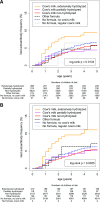First Infant Formula Type and Risk of Islet Autoimmunity in The Environmental Determinants of Diabetes in the Young (TEDDY) Study
- PMID: 28096222
- PMCID: PMC5319477
- DOI: 10.2337/dc16-1624
First Infant Formula Type and Risk of Islet Autoimmunity in The Environmental Determinants of Diabetes in the Young (TEDDY) Study
Abstract
Objective: Studies on the introduction of infant formulas and its effect on the risk of islet autoimmunity and type 1 diabetes (T1D) have yielded inconsistent results. We investigated whether the introduction of formula based on hydrolyzed cow's milk as the first formula is associated with reduced islet autoimmunity risk in a large prospective cohort.
Research design and methods: The Environmental Determinants of Diabetes in the Young (TEDDY) study prospectively monitors 8,676 children at increased genetic risk for T1D. Autoantibodies to insulin, GAD65, and IA2 were measured regularly to define islet autoimmunity. Information on formula feeding was collected by questionnaires at 3 months of age.
Results: In survival analyses, after adjustment for family history with T1D, HLA genotype, sex, country, delivery mode, breast-feeding ≥3 months, and seasonality of birth, we observed no significant association with islet autoimmunity in infants who received extensively hydrolyzed compared with nonhydrolyzed cow's milk-based formula as the first formula during the first 3 months (adjusted hazard ratio 1.38 [95% CI 0.95; 2.01]), and a significantly increased risk for extensively hydrolyzed formula introduced during the first 7 days (adjusted hazard ratio 1.57 [1.04; 2.38]). Using a partially hydrolyzed or other formula as the first formula, or no formula, was not associated with islet autoimmunity risk.
Conclusions: These results add to the existing evidence that islet autoimmunity risk is not reduced, and may be increased, by using hydrolyzed compared with nonhydrolyzed cow's milk-based infant formula as the first formula in infants at increased genetic risk for T1D.
© 2017 by the American Diabetes Association.
Figures
References
-
- World Health Organization. Infant and young child feeding data by country, 2016. Available from http://www.who.int/nutrition/databases/infantfeeding/countries/en/. Accessed 28 April 2016
-
- Gerstein HC. Cow’s milk exposure and type I diabetes mellitus. A critical overview of the clinical literature. Diabetes Care 1994;17:13–19 - PubMed
-
- Norris JM, Scott FW. A meta-analysis of infant diet and insulin-dependent diabetes mellitus: do biases play a role? Epidemiology 1996;7:87–92 - PubMed
-
- Virtanen SM, Kenward MG, Erkkola M, et al. . Age at introduction of new foods and advanced beta cell autoimmunity in young children with HLA-conferred susceptibility to type 1 diabetes. Diabetologia 2006;49:1512–1521 - PubMed
-
- Chmiel R, Beyerlein A, Knopff A, Hummel S, Ziegler AG, Winkler C. Early infant feeding and risk of developing islet autoimmunity and type 1 diabetes. Acta Diabetol 2015;52:621–624 - PubMed
MeSH terms
Substances
Grants and funding
- U01 DK063821/DK/NIDDK NIH HHS/United States
- UC4 DK063863/DK/NIDDK NIH HHS/United States
- HHSN267200700014C/DK/NIDDK NIH HHS/United States
- U01 DK063861/DK/NIDDK NIH HHS/United States
- UL1 TR001427/TR/NCATS NIH HHS/United States
- U01 DK063790/DK/NIDDK NIH HHS/United States
- UL1 TR001082/TR/NCATS NIH HHS/United States
- UL1 TR000064/TR/NCATS NIH HHS/United States
- U01 DK063836/DK/NIDDK NIH HHS/United States
- U01 DK063829/DK/NIDDK NIH HHS/United States
- U01 DK063865/DK/NIDDK NIH HHS/United States
- UC4 DK095300/DK/NIDDK NIH HHS/United States
- UC4 DK063861/DK/NIDDK NIH HHS/United States
- UC4 DK063829/DK/NIDDK NIH HHS/United States
- UC4 DK063821/DK/NIDDK NIH HHS/United States
- UC4 DK117483/DK/NIDDK NIH HHS/United States
- UC4 DK063836/DK/NIDDK NIH HHS/United States
- UC4 DK112243/DK/NIDDK NIH HHS/United States
- UC4 DK063865/DK/NIDDK NIH HHS/United States
- U01 DK063863/DK/NIDDK NIH HHS/United States
- UC4 DK106955/DK/NIDDK NIH HHS/United States
- UC4 DK100238/DK/NIDDK NIH HHS/United States
LinkOut - more resources
Full Text Sources
Other Literature Sources
Medical
Research Materials


